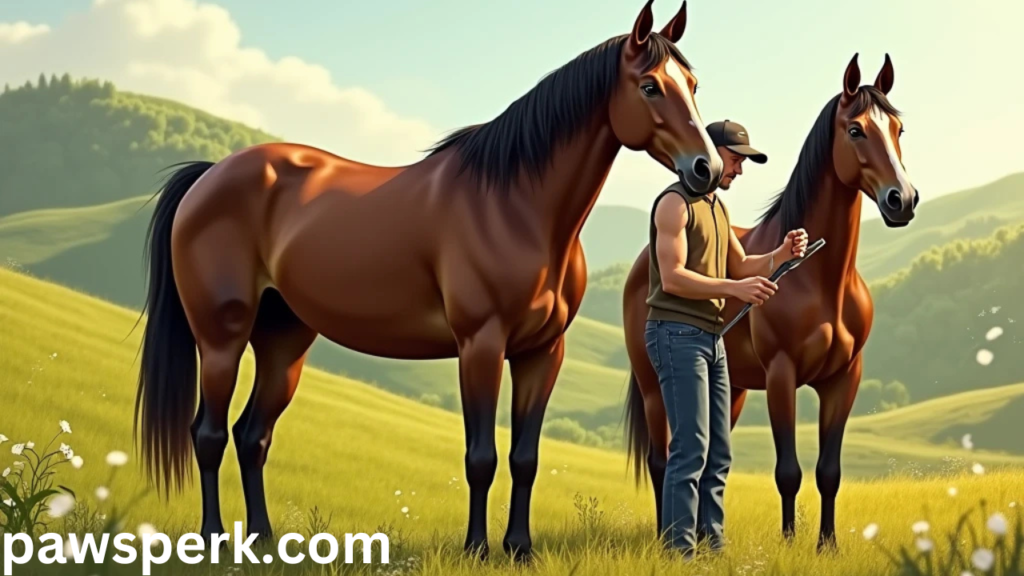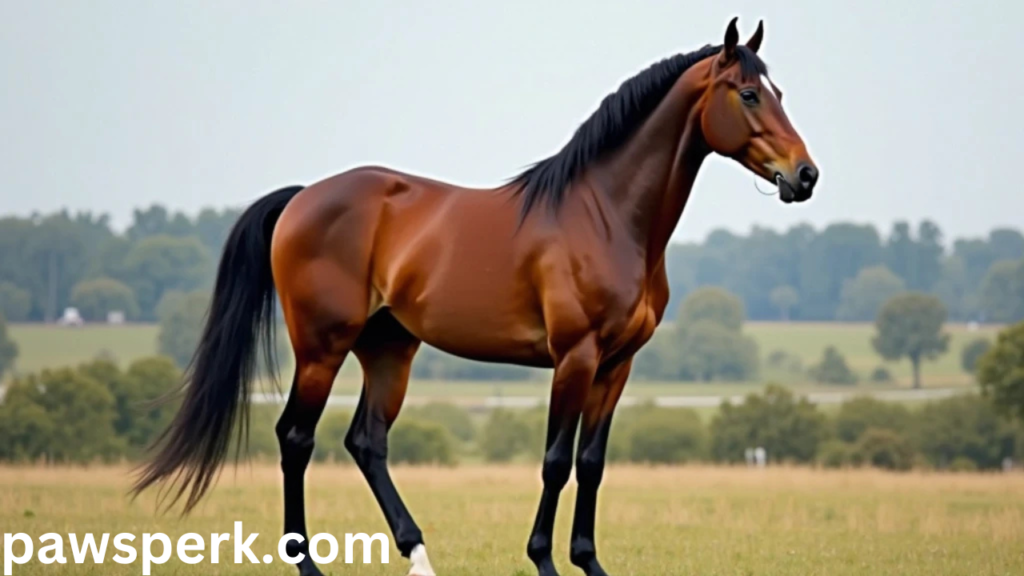The French Trotter Horse Size is a defining characteristic of this powerful and enduring breed. Known for its agility and stamina in harness racing, the French Trotter Horse Size plays a crucial role in its performance and longevity. This breed combines strength, speed, and endurance, making it a remarkable athlete. But what are the exact physical traits of the French Trotter Horse Size, and why does it matter so much? In this in-depth analysis, we will explore the French Trotter Horse Size, how its measurements influence performance, and how it compares to other trotting breeds.
An Overview of the French Trotter in Brief
In the 19th century, native French horses were crossed with Norfolk Trotters and English Thoroughbreds in Normandy to create the French Trotter. The intention was to create a horse that would excel in both mounted trotting races (trot monté) and harness racing (trot attelé). This breed is well known for its agility and versatility in equestrian activities and today dominates European racetracks.
Let’s go right to the question, though: why is the French Trotter’s size so important to its appeal?
You may also like: Castrated Male Horses: Care, Behavior & Benefits
The Data: Mean Weight and Height
Despite not being the tallest or heaviest horses in the equestrian industry, French trotters’ dimensions are ideal for their function. The following is the breakdown:
Height: Typically ranges from 15.3 to 16.3 hands, or 63 to 67 inches, or 160 to 170 cm at the withers.
Weight: 1,100 to 1,300 pounds (500 to 590 kg) can be the range, depending on gender and conditioning.
On the other hand, Thoroughbreds, famous for flat racing, are usually taller (16–17 hands), while draft breeds like Percherons can weigh over 2,000 pounds. The French trotter’s intermediate size ensures agility for quick turns on the track while retaining enough muscle strength to generate explosive power.
Anatomy of a Champion: Key Physical Traits
Size alone doesn’t define the French Trotter—its structure is engineered for efficiency. Let’s break down its build:
- Legs and Stride:
A longer stride, which is essential for sustaining pace in trotting races, is provided by long, lean legs. Their limbs are strong without being heavy, which lessens tiredness while exerting themselves vigorously. The sturdy and small hooves are perfect for stomping on uneven terrain. - Chest and Hindquarters:
A deep chest houses a large lung capacity, supporting endurance, while well-developed hindquarters generate the thrust needed for acceleration. Think of it as the difference between a sprinter’s surge and a marathon runner’s stamina—this breed balances both. - Back and Neck:
A slightly arched back and muscular neck contribute to balance and control, especially when navigating tight corners. This conformation helps jockeys or drivers maintain stability during races.
Why Size Matters: Performance on the Track
In harness racing, every inch and pound can mean the difference between victory and second place. Here’s how the French Trotter’s dimensions give it an edge:
- Speed and endurance:
At high speeds, their moderate height improves stability by lowering the center of gravity. Long-distance fatigue is avoided by their weight distribution, which is more robust than lighter racers but thinner than draft breedsBy trotting steadily for miles at 30 to 35 mph (48 to 56 km/h), a French trotter can outpace more substantial rivals. - Maneuverability:
On oval tracks, smaller stature enables tighter bends. This trait is very helpful in races like the Prix d’Amérique, Europe’s most famous harness race, when planning and quickness are essential. - Heat Regulation:
During races, a compact body reduces heat accumulation by minimizing surface area. A minor but important benefit of effective cooling is that it prevents muscles from prematurely becoming fatigued.
The French Trotter in Relation to Other Trotting Breeds
To determine the French Trotter’s size, let’s compare it to two other trotting experts:
- Standardbred (American Trotter):
- Height: Slightly shorter (15–16 hands).
- Build: More muscular, with a heavier frame suited for short-distance races.
- Key Difference: Standardbreds often prioritize raw power over endurance, while French Trotters excel in longer races.
- Orlov Trotter (Russian):
Height: Taller (16–17 hands), with a leaner frame.
- Build: Designed for elegance and smooth gaits, but less compact than the French Trotter.
- Key Difference: Orlovs are slower in harness racing but prized for their graceful movement in show settings.
The French Trotter’s “middle ground” in size makes it a hybrid of speed, strength, and staying power.
Breeding for Size: How Genetics Play a Role
French Trotter breeders meticulously select for size-related traits to optimize performance:
- Selective Pairing: To strengthen these qualities, stallions and mares with the right proportions—such as powerful hindquarters and balanced leg length—are matched.
- Avoiding Extremes: Smaller horses may not have long strides, while taller horses may experience joint discomfort. The “goldilocks zone” of 16 hands is what breeders strive for.
- Gender Differences: Both sexes compete equally in races, although mares are frequently a little lighter and smaller than stallions.
In order to ensure that efficiency is not compromised for beauty, modern breeding programs also employ gait analysis technologies to assess how a horse’s size affects its trotting mechanics.
Caring for a French Trotter: Size-Specific Considerations
Being a French Trotter owner involves more than just appreciating its size; it also entails providing for its physical requirements:
- Diet: To fuel their metabolism, these horses need high-energy feeds like barley and oats, but portions are carefully calibrated to avoid causing them to gain too much weight, which could slow them down.
- Exercise: Consistent training keeps muscles toned without putting undue strain on joints. Because of their size, they can be used for a variety of exercises, such as lengthy trots and interval sprints.
- Health Monitoring: Smaller French trotters require hoof care to prevent cracks from repeated impact, while larger ones may be more susceptible to suspensory ligament strain.
Debunking Myths About Size
Myth 1: “Bigger French Trotters are always faster.”
Reality: While muscle mass aids power, excessive bulk can hinder agility. The fastest horses often fall in the mid-range of the breed’s size spectrum.
Myth 2: “They are too fragile for non-racing pursuits.”
Reality: They are appropriate for dressage, show jumping, and recreational riding because of their balanced physique. For instance, retired French Trotter champion Ready Cash made a smooth transition to equestrian therapy as a second profession.
The Future of the Breed: Size Trends and Adaptations
The French trotter changes along with harness racing. The average height has increased by 0.5 hands in the last 20 years, which is probably the result of selective breeding for longer strides. Breeders are still cautious nonetheless, in order to maintain the breed’s distinctively small and robust frame.
Climate adaptability is another focus. With rising temperatures affecting race schedules, the French Trotter’s efficient heat regulation—a byproduct of its size—could become even more advantageous.

Conclusion: The Perfect Package
The size of the French trotter isn’t a coincidence; years of improvement have produced a horse that is a symbol of power, agility, and endurance. This breed demonstrates that balance is the most valuable quality in the horse industry, whether it is thundering down a racetrack or elegantly navigating a training course.
For aficionados, comprehending these dimensions is about more than simply numbers; it’s about recognizing the science and creativity that go into creating a living, breathing engineering marvel.


